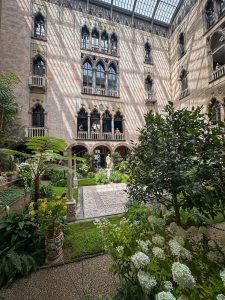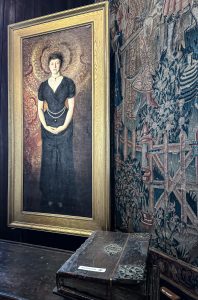Basking in Isabella’s Acquired Beauty
by admin | August 15, 2024 9:35 pm
BOSTON — I wish I could have been friends with Isabella Stewart Gardner. My Beautiful Mystery Companion and I are standing before a full-length portrait of her, painted in 1888 by John Singer Sargent and now ensconced in the Gothic Room of the museum that bears her name. The painting, which shows considerably less cleavage than the average teenage girl wandering any mall in America, at the time caused quite a scandal — prompting Isabella’s husband, Jack, to ask her to refrain from showing it in public. She respected his wishes. The painting remained visible by invitation only until her death in 1924.
Isabella began building a museum to house her vast collection of paintings, statuary, rare books, and manuscripts in 1889 after Jack died suddenly from a stroke. She came from family wealth that was multiplied by her husband’s business success, allowing them both to travel the world seeking acquisitions. After his death and once the museum was built, she left their home at 152 Beacon St. in Back Bay, filled with treasures, and moved the treasures into the newly built museum. She lived in private living quarters on the fourth floor of the museum, located in Boston’s Fens. That is a wetlands park designed by Frederick Law Olmstead, designer of New York’s Central Park. (Fenway Park adjoins the Fens, hence its name.) The museum opened in 1903 and now adjoins the campus of Simmons University.
The museum is stunning, reflecting the tastes and love for beauty that Isabella cultivated throughout her life. The courtyard is the focal point, riotous with color in summer, when flowers in New England reach their peak. My BMC immediately announced her willingness to simply live in the courtyard — at least until winter arrived. Alas, it was roped off, so we had to settle for taking photographs by leaning out the arched windows. [1]
[1]
I began reading The Lioness of Boston while on the plane to Boston. The historical novel, by Emily Franklin, is a carefully researched and fascinating account of Isabella’s life, written with great empathy and respect. Isabella was an independent free spirit, something rarely seen in the Brahmin society of genteel Boston in the 19th and early 20th centuries. It compelled me to order a new biography of Isabella published a few months ago, to find out even more and compare the details of the novel to a biography from a respected academic. My BMC has called dibs on reading it first, since she first read the novel and practically demanded I read it as well. I am glad she did.
The Gardner Museum is one of the most beautiful spaces we have ever visited. Isabella’s vision dominates the collections. In the year before Jack died, he and Isabella toured Europe — Italy in particular — and bought “columns, windows, and doorways, as well as reliefs, balustrades, capitals and statuary from the Roman, Byzantine, Gothic, and Renaissance periods,” as the website states. The result is a museum that feels as if one is visiting the very opulent home of a casual acquaintance. It is unlike any museum I have ever visited, which I suspect is the effect Isabella sought, as she dictated no pieces could be added or taken away from the museum’s collection.
very opulent home of a casual acquaintance. It is unlike any museum I have ever visited, which I suspect is the effect Isabella sought, as she dictated no pieces could be added or taken away from the museum’s collection.
There is one sad exception. Early on the morning of March 18, 1990, two men in police uniforms drove up to the museum’s side entrance and told the guard on duty they were responding to a disturbance. The guard let them in, and the thieves handcuffed the guards and tied them up in the museum’s basement. The thieves left 81 minutes later with 13 works of art. Stolen were works by Rembrandt, Manet, Degas, Vermeer, and others. It is still called the largest property theft in the world, with one report I found estimating the stolen works are now worth $600 million or more.
Empty frames still hang where the stolen paintings once were displayed in the Gardner, reminding visitors of the theft, still unsolved more than 34 years later. The museum continues to offer a $10 million reward for the return of the stolen artwork.
During her long life, Isabella became friends with many of that period’s finest artists, poets, writers, and thinkers. She became the first female member of Harvard’s Dante Society at the behest of Charles Eliot Norton, the college’s first professor of art history. She once walked a pair of lions on a leash from the Boston Zoological Gardens down Beantown’s sidewalks, sparking considerably publicity. She spoke her mind when few women in society did so.
One reporter wrote of her, “Mrs. Jack Gardner is one of the seven wonders of Boston… She imitates nobody; everything she does is novel and original.” Isabella left an amazing legacy of beauty for all of us fortunate enough to get to the Fens to enjoy.
Perhaps someday, we will return to bask in that beauty once more.
- [Image]: http://garyborders.com/pages/basking-in-isabellas-acquired-beauty/i-s-gardner-museum-1/
Source URL: https://garyborders.com/pages/basking-in-isabellas-acquired-beauty/